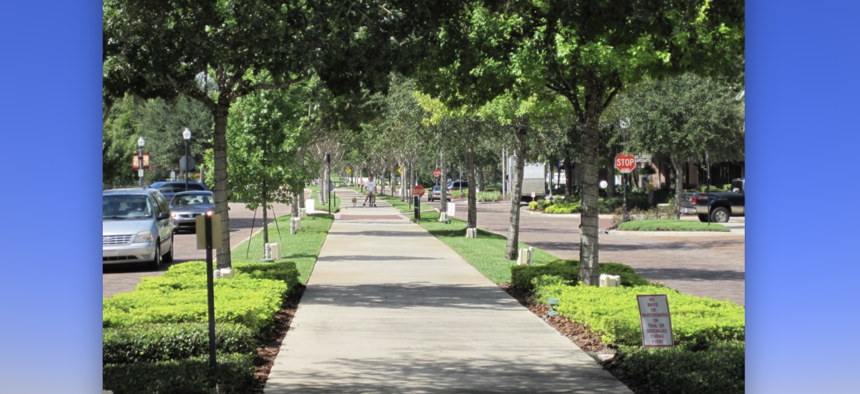Can't Get There From Here: The Missing Middle Along Florida's Coast-to-Coast Trail

A view of the West Orange Trail in downtown Winter Garden, Florida, part of the Coast to Coast Trail. Doug Alderson/Florida Department of Environmental Protection
Bicyclists tell of having to ride along busy highways as officials say an unfinished segment may be years more in the making.
This article was first published by Route Fifty partner publication City & State Florida.
Seven years ago, the Florida Legislature had a plan: Build a 250-mile hiking and biking path that connects the state’s coasts, from Titusville in the east to St. Petersburg in the west.
Fast forward to reality: The good news is that about 80 percent of what's now called the Florida Coast-to-Coast Trail is complete.
The bad news? A gaping 22-mile hole in Sumter County, near the small town of Webster.
That missing link forces cyclists to go from paths restricted solely to bikes and pedestrians to heavily traveled roads where traffic routinely exceeds the posted 55 mph speed limit.
"One jacked-up pickup truck slowed down as he passed us so he could blast us with his airhorn," says Mary Shanklin, an avid cyclist who rode through part of Sumter on State Road 471. "It pierced our ears so much and really shook up even the most veteran in our group of four. It almost ruined our trip.”
Shanklin, a book publisher who lives in Winter Garden, often rides long distances with her friends and eventually completed the Coast to Coast ride in November 2020 – despite what happened in Sumter. Unfortunately for Shanklin and other bicyclists, five more years may pass before the Sumter section is completed.
Michael Woods, executive director of the Lake-Sumter Metropolitan Planning Organization, says a planning study outlining the most likely route for the missing segment has recently been finished. Right now, it appears the path will run along State Road 50, which will be doubled in size in coming years from two lanes to four.
Getting through the so-called project development and environment, or PD&E, phase is an important step in the process, Woods says. Even so, it could take five years before any asphalt is finally poured for the bike path. So far, the Coast to Coast trail has been completed mainly by adding small links to already existing corridors, according to Florida Department of Transportation estimates.
The majority of paths in place are along abandoned railroad lines converted to bike and pedestrian trails. Among those linked together are the Seminole Wekiva, West Orange, South Lake and Van Fleet trails in Central Florida, as well as the Pinellas Trail on the West Coast and the East Central Florida Rail Trail in Volusia and Brevard counties on the East Coast.
The project was launched in 2015, when then-state Sen. Andy Gardiner of Orlando got legislation passed that changed how vehicle registration fees are spent. It siphoned off $25 million annually for what he called the SunTrail program for bike paths.
Gardiner, who was Senate president in 2014-16, envisioned the Coast to Coast as a recreational asset and an economic boost to the state. Cities such as Dunedin and Winter Garden have benefited from business generated by people using the bike paths running through them, he says.
“For these smaller communities, it is a game changer,” Gardiner adds.
Sumter County, however, has been hung up for years on trying to select an alignment. The problem, Woods says, is that any scenic routes went through mostly private property, which could prohibitively raise land acquisition costs.
Becky Alfonso, director of the Florida Bicycle Association, says she supports the State Road 50 alignment, even though it would be the least shaded and aesthetically attractive route. “Let’s connect it. Do the fine tuning later,” she says.
Shanklin agrees. “By nightfall,” she recalls, “we hit (State Road) 471 in Sumter County. The shoulder is mostly nonexistent and with interspersed pockets of traffic buzzing past and nowhere to go … Sumter left us with no option other than to suffer."
Dan Tracy was a reporter at the Orlando Sentinel for 35 years, covering numerous beats including transportation, City Hall, state and local politics, business and long-term projects, and is an expert on the Central Florida scene.
NEXT STORY: Lawmaker questions community doorbell surveillance





